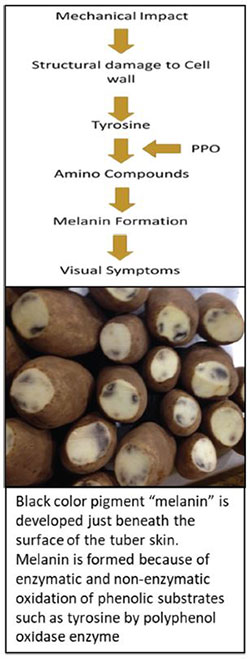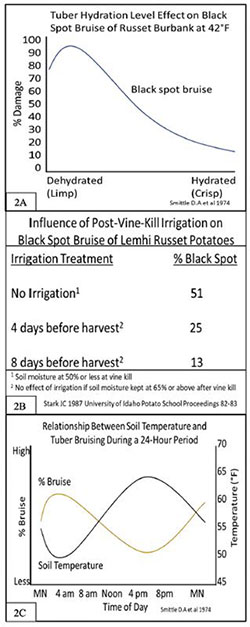by Sastry S. Jayanty* (6/19)
Quick Facts…
- Blackspot is a widespread type of impact damage in potato tubers caused by mechanical stress during harvest and handling.
- Every stage of harvesting, storing, packaging, and shipping operation should be evaluated and minimize the possibility of a bruise.
- Training employees is a critical component to reduce bruise damage.
- Dehydrated tubers are more susceptible to blackspot bruise.
Introduction

Figure 1
Blackspot is a widespread type of impact damage in potato tubers caused by mechanical stress during harvest and handling. It can significantly reduce tuber quality. Blackspot bruise is difficult to detect in intact tubers without peeling as the skin is not damaged. Blackspot is formed close to the vascular ring and generally at the stem end because of the melanin pigment formation when polyphenolic compounds are oxidized by the polyphenolic oxidase (PPO) enzyme during cell wall rupture with a mechanical impact (Figure 1). It takes 24 to 48 hours after an impact in the damaged area of the tuber to change color.
Blackspot is cosmetically undesirable because of discoloration. Blackening in the impact zone of the tuber is the main reason for the rejection of the crop by consumers and the processing industry resulting in considerable economic losses.
Cultural Management to Control Blackspot
Role of Potassium: There is a significant relationship between reduction in susceptibility to blackspot bruise with an increasing rate of application of potassium fertilizer. However, this effect is primarily observed in fields with potassium deficiency. Additional potassium fertilizer decreases the tuber dry matter content due to increased water uptake. Increasing potassium uptake may provide drought tolerance.
Role of Nitrogen: Excess nitrogen and late application causes a delay in vine maturity and increases the tubers’ blackspot bruise susceptibility. Excess application of nitrogen is also associated with reduced dry matter.
Role of Calcium: Enhancing tuber calcium concentration may reduce the incidence of blackspot bruise. Bruise incidence is minimized at 250ppm of tuber calcium concentration. Cultivars respond differently to calcium application as they differ in uptake and accumulation.
Role of Dry Matter and Specific Gravity: Blackspot bruising potential is high in tubers with high dry matter content (specific gravity). Higher specific gravity tubers contain larger starch granules which account for damage potential to cell membranes with mechanical impact. However, different cultivars with the same specific gravity may exhibit different levels of susceptibility which is determined by two tuber qualities. First is a separation of substrate and enzyme within the cells. Second is the biochemical potential to synthesize blackspot pigments which depend on the polyphenol oxidase enzyme (PPO) and its substrate (tyrosine) levels. It has also been proposed that the intensity of the dark color is proportional to the number of cells damaged and smaller cell size.

Figure 2
Role of Tuber Turgidity: Dehydrated tubers are more susceptible to blackspot bruise (Figure 2A). Turgidity of the tubers depends on tuber hydration status. Turgor pressure is attributed to water contained in the vacuole within the cells and determines the mechanical properties of tubers. Reducing relative turgor can reduce tissue stiffness can can make the tuber more ‘selfcushioning’ by distributing a given force over a larger area of the curved tuber surface. Tuber hydration status determines the kind of bruise and the extent of blackspot bruise susceptibility.
Vine Kill: The potential for blackspot increases with vine maturity. More dead vines before vine kill can cause more blackspot bruises due to tuber dehydration. Soil moisture levels after vine kill and during the harvest will affect tuber hydration level. Optimum tuber hydration status can be achieved by maintaining adequate soil moisture after vine kill through harvest and harvesting under ideal temperature (Figure 2B).
Harvesting: Narrow walled tires on tractors and harvesters should be used, and uniform spacing must be maintained to reduce lateral pressure on the hill to prevent damage to tubers that are set high in the hill. Rolling of vines can increase the chances of tuber damage, especially in fields with more rocks and stones. Tuber pulp temperatures between 50-60 °F are ideal for harvesting and handling (Figure 2C). To minimize mechanical injury, reduce drop height between conveyor belts and the use of a cushion where tubers drop in all phases of moving in and out of storages. Warm the tubers (minimum 45°F) before handling or moving as cold tubers are more susceptible to bruising. Tubers are less susceptible after one month of curing and can withstand more impact compared to freshly harvested tubers.
Measures to Reduce Blackspot Bruise
- Education: Preventing potato bruising is a team effort. Every stage of harvesting, storing, packaging, and shipping operation should be evaluated and minimize the possibility of a bruise. Training employees is a critical component to reduce bruise damage.
- Fertility Management: Late nitrogen application to extend tuber bulking can delay vine maturity and increase tuber susceptibility to bruising at harvest. Avoid any deficiency of potassium and calcium as they have a role in tuber turgidity and blackspot bruise.
- Pulp Temperature: Handling tubers below 45 °F can cause more bruise damage. Pulp temperatures between 50 to 60 °F are recommended for harvesting and handling.
- Tuber Hydration: Dehydrated tubers are more susceptible to blackspot bruise. After vine kill, onequarter of an inch of irrigation is recommended to keep the soil moist around the tubers to prevent tuber dehydration until harvest.
- Drop Height & Drop Surface: To reduce mechanical injury, reduce drop height between conveyor belts and the use of a cushion at the tuber drop zone during harvesting and handling.
Conclusions
The grower has to compromise between low bruising and high specific gravity to achieve the best economic return. Harvest and handling conditions, system improvements, and cultural practice changes can be used to reduce black spot bruising.
References
- Brook, R.C. 1996. Potato Bruising. National Potato Anti-bruise Committee.
- Corsini, D., J. Stark, and M. Thornton. 1999. American J of Potato Research 221-226.
- Henry C. Castleberry, Sastry S. Jayanty. 2017 Susceptibility to pressure flattening correlates with texture analysis of potato tubers. American J of Potato Research 94: 556–566.
- Preventing Potato Bruise Damage edited by Thornton M & Bohl W. 1998. Cooperative Extension System Agricultural Experiment Station BUL 725 (Revised) University of Idaho.
- McGarry, A, Hole CC, Drew RLK, Parsons N. 1996. Internal damage in potato tubers: a critical review ’Postharvest Biology and Technology 8: 239-258.
- Simson R, Tartlan L, Nugis E and Eremeev V 2016. The effect of fertilizer and growing season on tuber dry matter and nitrate content in potato Agronomy Research 14: 1486–1493.
- Smittle D.A et al. 1974 Harvesting potatoes with minimum damage American Potato J. 51:153-164.
*Sastry S. Jayanty, Associate Professor and Extension Specialist, San Luis Research Center, Department of Horticulture and Landscape Architecture Colorado State University,
Sastry.jayanty@colostate.edu.





